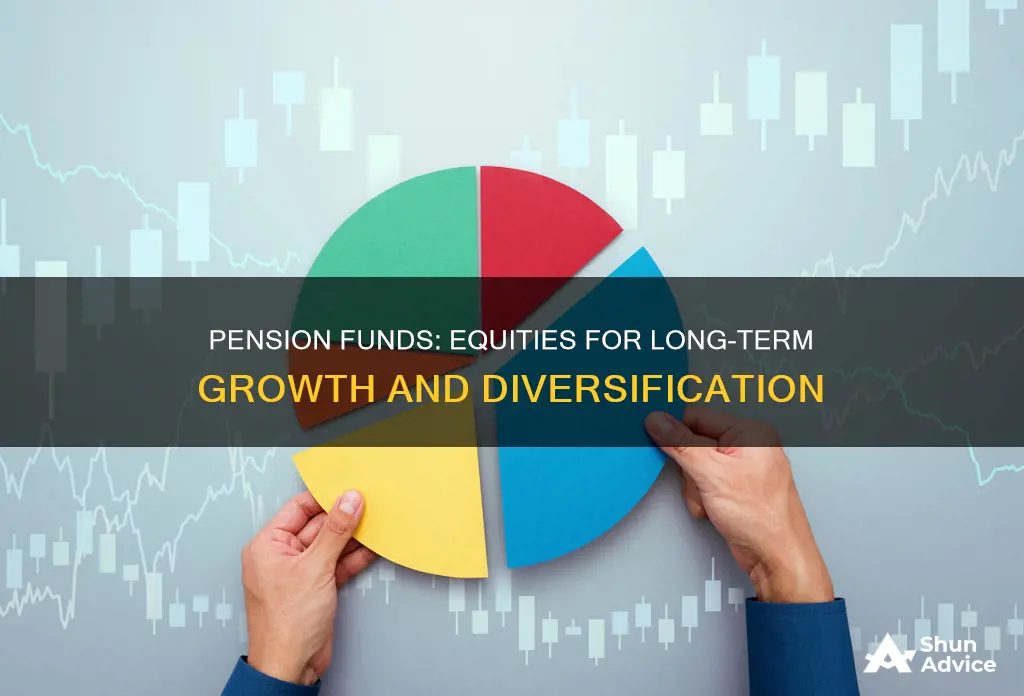
Pension funds have traditionally invested in stocks and bonds, but changing market conditions have led to a shift in investment strategies. Pension funds now seek to invest in a variety of asset classes, including private equity, real estate, infrastructure, and securities like gold. This diversification is driven by the need to maintain a high enough rate of return while prudently managing assets to ensure retirees receive their promised benefits. The traditional 70-30 model, where 30% of assets were invested in publicly listed stocks, is being replaced by investments in private companies, offering improved diversification by region, industry, and sector. This shift towards private equity, including venture capital, has accelerated since 2009-2010, with pension funds seeking higher returns and greater diversity.
| Characteristics | Values |
|---|---|
| Diversification | Pension funds diversify their investments across asset classes, including equities, bonds, real estate, and alternative investments like private equity, hedge funds, and commodities. |
| Risk and Return | Pension funds seek to balance risk and return, with a focus on long-term growth. They may invest in higher-risk equities for potentially higher returns, especially in a low-interest-rate environment. |
| Liquidity | Pension funds consider the liquidity of their investments. Private equity investments, for example, are less liquid than publicly-listed stocks. |
| Regulatory Requirements | Pension funds operate within regulatory frameworks that guide their investment strategies and require them to act in the best interests of future retirees. |
| Liability Management | Pension funds manage their liabilities by investing in assets that match their future obligations to retirees. They use strategies like liability-matching to ensure they can meet their benefit promises. |
| Inflation Protection | Pension funds invest in assets that provide inflation protection, such as inflation-adjusted bonds, commodities, and real estate. |
| Active vs. Passive Management | Pension funds may employ active or passive investment strategies. Active management involves more frequent adjustments and the use of external managers, while passive management adheres to a long-term strategy with less frequent adjustments. |
What You'll Learn

Pension funds are increasingly investing in private equity
Private equity investments provide pension funds with access to unique assets that are not available on public markets. This allows for greater diversification by region, industry, and sector, as well as the ability to invest in a wider selection of companies, including privately held ones. Additionally, private equity is known for its high returns, which can help pension funds make up for any funding shortfalls.
However, private equity investments also come with certain drawbacks, such as a lack of transparency, high fees, and reduced liquidity. These factors have led to criticism of some underperforming pension funds that have invested in private equity.
Despite these risks, many pension funds have successfully implemented private equity strategies, achieving high returns and proving that private equity can be a lucrative investment option. Ultimately, while pension fund managers need to be cautious and strategic in their approach, investing in private equity can be a valuable way to boost returns and diversify their portfolios.
Mutual Fund Investment: Smart Money Moves to Make Now
You may want to see also

Pension funds are moving away from traditional equities
For decades, pension funds have primarily invested in traditional asset classes due to their predictable capital preservation, returns, and liquidity. However, with increasing longevity, aging populations, and lower yields from traditional investments, pension funds are rethinking their strategies. By diversifying into riskier alternative investments, pension plans aim to consistently generate enough wealth to meet their obligations.
The trend towards alternative investments gained momentum after the 2008-2009 financial crisis, which led to a prolonged period of low-interest rates that made bonds and other traditional asset classes less attractive. Additionally, stock market volatility during this period pushed pension plans to seek alternatives that could stabilize portfolio volatility while offering higher returns. As a result, asset classes like private equity and real estate gained favor due to their potential for higher, uncorrelated returns compared to public markets and bonds.
While this shift towards alternative investments is prominent, some funds continue to favor more conservative strategies, especially those with obligations to guarantee investment returns, high liquidity needs, and low-risk tolerance. The investment strategies of pension funds also vary based on factors such as national regulations and the demographics of their membership.
In summary, pension funds are moving away from traditional equities towards alternative investments to enhance long-term returns, manage risk, and adapt to changing market conditions. This evolution in investment strategies reflects the need for pension funds to balance liquidity, risk management, and long-term growth to protect the financial security of their beneficiaries.
Investment Trust vs Fund: What's the Difference?
You may want to see also

Pension funds are investing in alternative assets
Pension funds are increasingly investing in alternative assets, such as private equity, hedge funds, commodities, derivatives, and high-yield bonds. This shift is driven by the need for higher returns to meet promised retirement benefits and counter the diminishing returns from traditional investments like bonds and large-cap public equities.
Private equity, a long-term alternative investment, is one of the most popular choices for pension funds. It involves investing in the equity of privately held companies with the aim of substantial gains upon liquidation. Pension funds are a significant source of capital for the private equity industry. However, these investments are risky due to their complex nature, lack of transparency, and potential for unexpected losses.
Other alternative investments include hedge funds, commodities, real estate, and tangible assets like art and collectibles. These investments are often less regulated and more illiquid than traditional investments. They are typically aimed at institutional or accredited investors with a high net worth due to their complexity and high minimum investment requirements.
While alternative investments carry higher risks, they also offer potential benefits such as diversification, higher returns, and protection against inflation. This makes them attractive to pension funds seeking to balance their portfolios and ensure sufficient returns to cover promised benefits.
Invest Wisely: Choosing the Right Army Fund
You may want to see also

Pension funds are actively managed
Pension fund managers have traditionally split their assets among bonds, stocks, and real estate. However, in recent years, pension funds have been shifting their targets from traditional equities and bonds to alternative assets, such as private equities, hedge funds, real estate, and commodities. This shift is often attributed to a desire for greater diversification and risk reduction, but studies suggest that the main motivation is reaching for higher returns.
Pension funds have long investment horizons, which means they can afford to take a long-term view of their investments. This allows them to invest in less liquid assets, such as private equity, which may offer higher returns over the long term. Additionally, large pension funds typically have long-dated liabilities, reducing the likelihood of facing liquidity shocks in the medium term.
The active management of pension funds also involves regularly adjusting investment targets based on evolving beliefs about capital markets and diversification. This reflects a more dynamic investing style that aims to optimise returns while managing risk.
While some critics argue that pension funds could achieve better returns by investing solely in passive index funds, this assertion is debated. The performance of pension funds relative to passive strategies depends on the time period analysed and the specific market conditions during that time.
In summary, pension funds are actively managed by professionals who are legally bound to act in the best interests of future retirees. This active management involves strategic asset allocation, regular adjustments, and a long-term investment horizon, all aimed at optimising returns while managing risk.
Best Mutual Funds for Tax Savings: Where to Invest?
You may want to see also

Pension funds are diversifying their portfolios
Traditionally, pension funds primarily invested in stocks, bonds, and real estate. However, changing market conditions and the need to maintain competitive returns have led pension funds to explore other investment opportunities. Today, pension funds are increasingly allocating capital to private equity, hedge funds, commodities, derivatives, high-yield bonds, and infrastructure.
Private equity investments, in particular, have gained traction among pension funds. By investing directly in private companies or through private equity funds, pension funds can improve their ability to diversify across regions, industries, and sectors. This strategy also provides access to a broader range of companies, including those that are privately held and not listed on stock exchanges.
Pension funds' diversification into alternative investments is driven by several factors. Firstly, it offers statistical diversification as these investments are partially decorrelated from listed securities (stocks and bonds). Secondly, there is an expectation of superior risk-adjusted returns over longer periods, typically 8 to 10 years. Additionally, investing in private equity provides access to early-stage industries and fiscal incentives for investments in SMEs and innovative technologies.
Large pension funds, with their long-dated liabilities, are well-suited for private equity investments due to their lower likelihood of facing liquidity shocks in the medium term. This allows them to accommodate the long holding periods typically required for such investments.
By diversifying their portfolios, pension funds aim to enhance returns, manage risk, and ultimately ensure that retirees receive the promised retirement benefits.
Covered Funds: A Smart Investment Strategy?
You may want to see also
Frequently asked questions
Pension funds have traditionally invested in equities, bonds, and real estate. However, in recent years, pension funds have been shifting their investments towards alternative assets, such as private equities, hedge funds, and commodities. This shift is driven by the need to maintain high returns and diversification, as well as to manage risk and volatility.
Investing in equities can provide pension funds with higher returns over the long term, contributing to the overall growth of the pension fund. Equities can also offer diversification benefits, especially when investing in a variety of companies across different regions, industries, and sectors.
One of the main risks of investing in equities is the potential for higher volatility and losses. The value of equities can fluctuate more significantly than other asset classes, and there is a higher risk of capital loss if the investments are not properly managed.
Pension funds typically have investment policies and targets in place to guide their asset allocation decisions. These targets are based on factors such as the plan's liability stream, expected revenue from contributions, and investment earnings. The funds regularly review and adjust their targets based on market conditions and their evolving beliefs about capital markets and diversification.
Yes, pension funds are required to operate as fiduciaries, which means they must act in the best interests of their clients (future retirees). By law, their investments must be prudent and diversified to prevent significant losses. Additionally, public pension funds follow regulations established by governing bodies, while private pension plans are subject to federal regulations such as the Employee Retirement Income Security Act (ERISA) in the United States.







